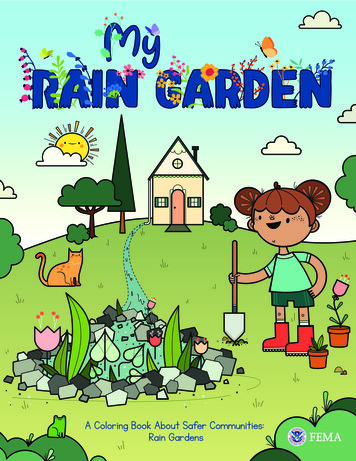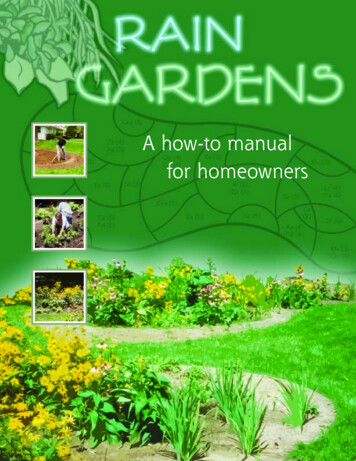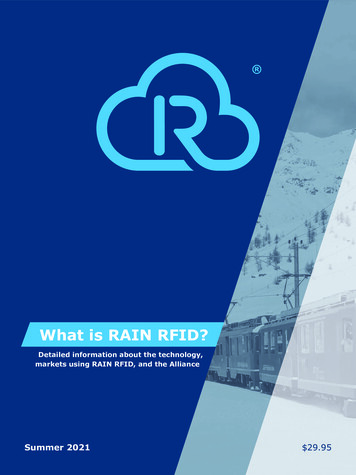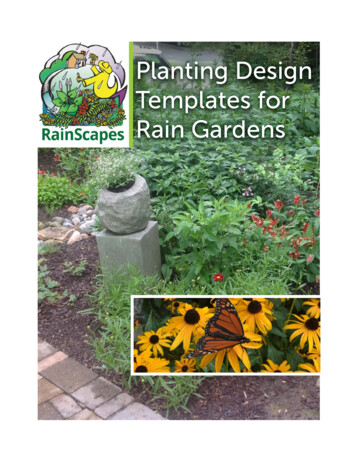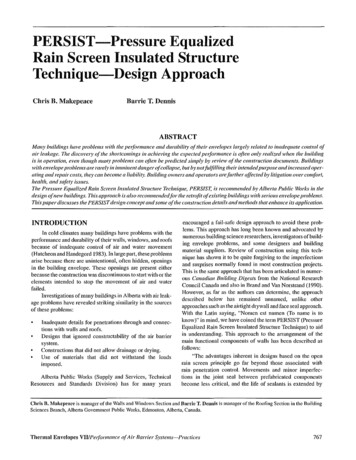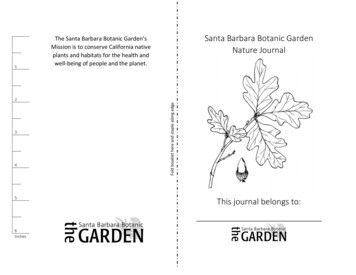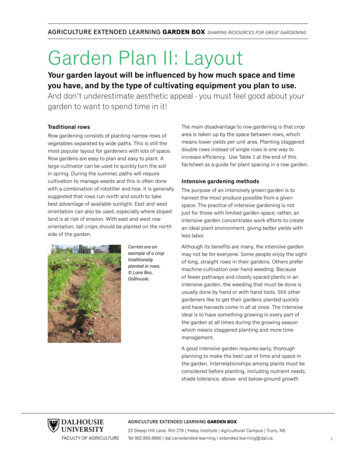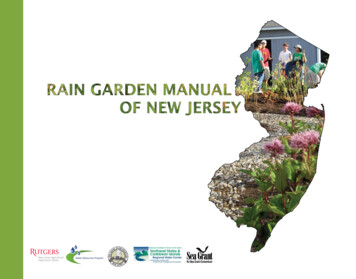
Transcription
RAIN GARDEN MANUALOF NEW JERSEY
ContentsForward06Introduction14Planning Your Rain Garden32Installing Your Rain Garden42Maintaining Your Rain Garden48ConclusionAppendix
PROJECT TEAMRutgers Cooperative ExtensionWater Resources ProgramNative Plant Society of New JerseyChristopher C. Obropta, Ph.D., P.E.Jeremiah D. Bergstrom, LLA, ASLAAmy C. BoyajianCaitrín S. Higgins, LEED APKathleen V. SalisburyWilliam E. Young, MS, RLA, PWSwww.water.rutgers.eduwww.npsnj.orgSpecial thanks to all of our partners throughout New Jersey whohave contributed photographs and images to help make this Manuala success for the Rain Garden State!Front cover photo courtesy of Pat EisemannCooperating Agencies: Rutgers, The State University of New Jersey, U.S. Department ofAgriculture, and County Boards of Chosen Freeholders. Rutgers Cooperative Extension, a unitof the Rutgers New Jersey Agricultural Experiment Station, is an equal opportunity programprovider and employer.This material is based upon work supported in part by the Cooperative State Research,Education, and Extension Service, U.S. Department of Agriculture, under Agreement No.2008-51130-19504. Any opinions, findings, conclusions, or recommendations expressed inthis publication are those of the author(s) and do not necessarily reflect the view of the U.S.Department of Agriculture.
Welcome!The Rutgers Cooperative Extension Water Resources Program and theNative Plant Society of New Jersey are excited to share this Rain GardenManual with you. Rain gardens are an easy way for everyone in NewJersey to help protect our State’s precious water resources and add tothe health and diversity of our native habitats and landscapes. Theseshallow landscaped depressions are able to intercept, treat, and infiltratestormwater at its source (your yard and home) helping to protect the qualityof our lakes, rivers, and streams and recharge our groundwater. Every dropof water kept out of our storm drains reduces flooding, mitigates pollution,and improves base flow in our waterways.We look forward to introducing you to the beautiful native plants thatcan be used in rain gardens. These many trees, shrubs, wildflowers andgrasses adapted to our State provide both aesthetics and function in yourlandscape.This manual is intended to give you the step-by-step procedure you needto create a beautiful and sustainable rain garden landscape. Rain gardensare something everyone can do. This manual will walk you through thefears or reservations you might have and will give you encouragement, aswell as the tools and answers you need to create and sustain a rain gardenon your property. Remember, a rain garden is one of the best and easiestthings you can do to protect and conserve New Jersey’s natural resources.Christopher C. Obropta, Ph.D., P.E.Rutgers Cooperative ExtensionWater Resources ProgramImage Courtesy of Thomas MuseKathleen V. SalisburyNative Plant Society of New Jersey
Wheaton Arts and Cultural CenterMillville, Cumberland County, NJ
Key Points:CHAPTER 1 Impervious surfaces prevent groundwater infiltration andenable stormwater runoff and nonpoint source pollutants toenter waterways. A rain garden is a landscaped, shallow depression thatcaptures, filters, and infiltrates stormwater at the sourcebefore it becomes runoff. A rain garden should reduce runoff, recharge groundwater,and use native plants. Native plants control erosion by stabilizing soils and increaseinfiltration, leading to an overall improvement of water quality. Installing a rain garden is a simple way to save money andenergy, while also preserving New Jersey’s natural resources.page 7
IntroductionWhy a Rain Garden?83 KEY POINTS:A Rain Garden should: Reduce Runoff Recharge Groundwater Use Native PlantsRain that falls to the earth evaporates into the atmosphere,is used by plants, or infiltrates down through the soil into thegroundwater. The remainder of the rainfall flows across theland surface into gutters, drains, streams, rivers, and lakes asstormwater runoff. As the rain moves over the land surface,it washes off pollutants and carries these contaminants tolocal waterways. The pollution that is carried by stormwaterrunoff to our waterways is called nonpoint source pollution(see “Nonpoint Source Pollution” information on page 10).Stormwater runoff that carries nonpoint source pollutionto our waterways is the major reason many of our streams,rivers, estuaries, ponds and lakes are not meeting water qualitystandards and are considered impaired. In fact, nonpointsource pollution in stormwater runoff causes up to 60% of ourexisting water pollution problems, making it the largest sourceof pollution in our New Jersey waters (NJDEP, Bureau of NonpointPollution Control, Division of Water Quality).Rain gardens are a simple, cost-effective tool homeowners,municipalities, and schools can use to reduce stormwaterrunoff, improve groundwater recharge, and trap nonpointsource pollutants before they reach our waterways.Holy Nativity Lutheran ChurchWenonah, NJRain Garden Manual of New Jersey
CAPTUREA rain garden catches runoff andholds standing water for no morethan 24 hoursFILTERIn the soil, microbes break downpollutants and nutrients washed in bythe rainINFILTRATEDeep-rooted plants loosen the soil,creating a sponge zone. Water soaksin and groundwater aquifers arerechargedDownspoutdischarging roofrunoff to yard orrain garden9Rain garden plantsfiltering runoffStorm sewer pipedischarging tostream or riverRoot “sponge”zoneRunoff fromdriveways & roadscarrying nonpointsource pollutionImage Courtesy of the City ofMaplewood, MN
Stormwater and You10Development activities throughout New Jersey are rapidlycovering the land with impervious surfaces like roadways,driveways, and rooftops. These impervious surfaces increasethe amount of stormwater runoff and nonpoint source pollutants carried to nearby waterways. These areas also preventwater from infiltrating into the ground, thereby deprivinggroundwater aquifers of the water they need to remain stable.Approximately half of the water we use in New Jersey comesfrom groundwater aquifers. Additionally, groundwater providesmany of New Jersey’s streams with “baseflow”. During the longperiods between rainfall, groundwater seeps into our streams,keeping them flowing and sustaining aquatic life. This baseflowprovided by the groundwater to the stream is critical in keepingstreams healthy and viable.In addition to the impervious surfaces associated withdeveloped communities, many of the soils in these areas aredisturbed and compacted during the development process.Even though turf grass is often covering these compacted soils,the infiltration capacity of these areas is greatly decreased.Compaction reduces the amount of rain that can infiltratethrough soils and increases stormwater runoff by two to tentimes from that of natural (undeveloped) landscapes.Natural landscapes, including wetlands, meadows, and forests,consist of native plant communities adapted to specific climate,soil, and hydrologic conditions. The roots of these plants helpto make the land very porous so that the soil quickly infiltratesrain that falls to the land surface.What is a rain garden?A rain garden is a landscaped, shallow depression thatcaptures, filters, and infiltrates stormwater runoff. The raingarden removes nonpoint source pollutants from stormwaterrunoff while recharging groundwater. A rain garden has twomain goals. The first goal is to serve as a functional system tocapture, filter, and infiltrate stormwater runoff at the source,and the second goal is to be an aesthetically pleasing garden.Rain gardens are an important tool for communities andneighborhoods to create diverse, attractive landscapes whileprotecting the health of the natural environment.NONPOINT SOURCE POLLUTION:“Nonpoint source pollution” is also called “peoplepollution.” It is the pollution that comes from oureveryday lives. It is the fertilizers that wash off ourfarms and lawns. It is the pet waste that washes intoour streams. It is the sediment (or soil) that erodesfrom our lands into our local waterways. It is the oiland grease that comes from our parking lots. Finally,it is the pollutants such as nitrogen, phosphorus, andheavy metals that settle out of our atmosphere ontoour roads and rooftops. When it rains, the stormwaterrunoff carries nonpoint source pollution and mayultimately wash it to our waterways.oil greasevisible in runoffAs the image on the left illustrates, stormwater runoff picks up oil and greasefrom the parking lot, flows through a curb cut, and into a rain garden. The raingarden acts as a sponge to trap the nonpoint source pollutants, preventingthem from reaching the nearby lake.Rain Garden Manual of New Jersey
A Rain Garden can be.Rain gardens can be readily implemented throughout ourcommunities to begin the process of re-establishing the naturalprocesses of the land. Rain gardens: capture stormwater runoff reducing erosion andsedimentation and the amount of water that flows to ourstreams and waterways during rain storms,a butterfly habitatalong a sidewalktrees and shrubsa parking islanda wet meadowa perennial garden protect water quality by filtering out and breakingdown pollutants, infiltrate runoff and thereby recharge groundwatersupplies and provide baseflow to nearby streams andwaterways, provide the opportunity to establish native plantcommunities to promote biodiversity and habitat forbeneficial wildlife, and integrate necessary soil improvements and nativeplants adapted to periodic wet and dry periodsmimicking our New Jersey natural landscape.While the Environmental Protection Agency (EPA) definesstormwater runoff as the number one threat to water qualityin our lakes and streams, rain gardens are one of the quickestand easiest methods everyone can use to reduce runoff andhelp protect our water resources. Beyond the aesthetic andecological benefits, rain gardens encourage environmentalstewardship and community pride. In addition, using nativeplant materials in rain gardens is an important way to promotebiodiversity and preserve native species in our developedcommunities. When used throughout a community, raingardens can also provide significant economic benefits bylowering costs for local government and businesses to maintainand upgrade traditional stormwater infrastructure pipes andmanagement basins.How does a rain garden differ from any other garden?To a certain extent, a traditional landscaped bed or flowergarden can provide functions similar to a rain garden. But, toprovide all the benefits of a rain garden including capturing,Photo courtesy of Bill Youngfiltering, and infiltrating stormwater runoff, a shallow basinmust be dug and planted slightly below-grade to store water.Ideally, a rain garden is planted with a variety of grasses,wildflowers, and woody plants that are adapted to the soil,precipitation, climate, and other specific site conditions. Usingnative plants with deeper root systems facilitates infiltrationand also sustains the landscape through periods of drought thatsometimes occur in our New Jersey summers.Native plants provide a multitude of benefits to both the localecosystem and the homeowner. For local wildlife, native plantssupply food and habitat. In addition, most native plant speciesproduce long root systems. For example, a non-native turfgrass, such as Kentucky bluegrass, has roots that typically reachonly six to eight inches in depth, while the roots of a nativegrass like big bluestem will extend to nine feet deep. Not onlydo these longer root systems help stabilize soils by controllingerosion, they also increase infiltration to lessen the impactsof floods and droughts, leading to an overall improvement inwater quality. Once established, native plants require very littlemaintenance, as they typically do not require irrigation or theapplication of pesticides or fertilizers.11
Burlington County1. Rutgers Cooperative Extension of Burlington CountyWhere can you see a raingarden in New Jersey?Cape May County2. Rutgers Cooperative Extension of Cape May CountyMany rain gardens havebeen installed throughoutNew Jersey. Below areseveral locations where greatexamples of rain gardens canbe found. Before beginningthe process of planning andinstalling your rain garden,visit one located near you.15161441817Cumberland County3. Wheaton Arts and Cultural CenterEssex County4. Essex County Environmental CenterGloucester County5. Holy Nativity Lutheran Church911126. Greenwich Township Library127.10131Atkinson Park8. Hurffville Elementary SchoolHunterdon County9. Marion F. Clawson Memorial ParkMercer County10. Mercer County Community College6511. Delaware River Basin Commission8Middlesex County12. Rutgers Cooperative Extension of Middlesex County(EARTH Center)7Monmouth County13. Rutgers Cooperative Extension of Monmouth County(Agriculture Building)3Morris County14. Washington Township Library215. Leonard Park16. Parsippany-Troy Hills Town HallUnion County17. Fanwood Memorial LibraryFor more information on demonstration rain gardens near you,visit www.water.rutgers.eduRain Garden Manual of New Jersey18. Hanson House/ Hanson Park ConservancyReeves-Reed Arboretum
How do you build a rain garden?The design of a rain garden involves understanding severalinterrelated principles including: the hydrologic cycle or water cycle, nonpoint source pollution, natural resource conservation, wildlife habitat, nutrient cycles, soil chemistry,SAVE MONEY SAVE ENERGY: horticulture,Planting a rain garden can save you money on yourenergy bill: landscape architecture, Carefully situated plants, particularly deciduoustrees located on the southern and western sidesof your house, can reduce your energy bill by upto 25% for a typical household. Planting deciduous trees along the southernand western sides of your house contributes to acooler house in the summer, while still allowingfor the sun to shine in the windows in the winter.13 design, ecology, and more.While these many principles may sound complicated, thismanual provides the information you need and the simple stepby-step instructions that will allow you to enjoy creating yourown rain garden to protect the water resources of New Jerseyand enhance your landscape. Trees, shrubs, or vines provide shade and act aswindbreaks. Summer air temperatures can be three to sixdegrees cooler in tree-shaded neighborhoods.Sumner Elementary SchoolCamden, NJ
Princeton, Mercer County, NJPhotograph courtesy of Curtis Helm
Key Points: Disconnect impervious surfaces. Place a rain garden betweentwo impervious surfaces to control and slow down stormwaterbefore it becomes runoff.CHAPTER 2 The size of a rain garden is dependent upon the amount ofrunoff entering the rain garden (determined by drainage area). The depth of the rain garden is dependent upon the soiltexture of the site. Good soil infiltration is important. Adding coarse sand to therain garden’s soil will improve infiltration rates. Clayey soils, in particular, need coarse sand and compostamendments. Select appropriate native plant species based upon the zonesof the rain garden. Plants that prefer wet conditions belong inthe base of the rain garden, plants that tolerate wet and dryconditions equally belong on the slope, and plants that preferdry conditions belong on the buffer of the rain garden.page 15
How to BeginGoals & Strategies16Setting goals and strategies will help guide you through theprocess of building a rain garden. In addition to the obviousgoal of designing and building a rain garden, another keyconsideration should be to better manage stormwater runoff.Installing a rain garden may also fulfill other goals such as toreduce irrigation of the lawn and landscape. The strategy ofthis goal could then be to plant only native plants in the raingarden. Other methods of achieving goals for a rain gardenproject may include: catching 50% of runoff in the rain garden,or using captured water in rain barrels to water plants in therain garden.BudgetIt is important to consider costs prior to beginning a raingarden project. If you construct the rain garden yourself,without hiring a landscaper, a residential rain garden cantypically average between 3 to 5 per square foot to install,depending on soil conditions, the desired plant species, andthe size and density of plants used. For projects incorporating curbing, storm drains, or underdrains, the cost of the raingarden will increase. It is recommended that you reach out to alandscape professional for support in the design and construction of these more complex projects. Generally, the cost ofplants will be the majority of the total cost of the project. Referto pages 60-66 of the Appendix for a list of recommendedplants and concept sketches. Call a local nursery to determinecosts of plant materials.Rain Garden Manual of New JerseyVillage SchoolHolmdel, NJ
Site SelectionLocating Your Rain GardenThe first step is to identify an appropriate location on yourproperty for constructing the rain garden. Consideration mustbe given to where the water will enter, how it will fill up therain garden, and where it will flow out. Remember that you willwant to control how the rain garden overflows during a largestorm. Where will the water go when it overflows? Considerthe impact of this potential overflow, and try to minimize itby directing the overflow towards grassy areas, wooded areas,or existing storm drains. Make sure that the rain garden willneither drain towards your foundation, nor towards the neighboring property.There are several important things to consider when selectingthe site of a rain garden:1. For a building with a basement, the rain garden shouldbe located at least ten feet from the building. This willprevent water from seeping into the building’s basement. Fora building with no basement, the rain garden can be placedtwo feet away from the building.2. Do not place the rain garden within 25 feet of a septicsystem, and make sure that the rain garden is placed upslopeof any leach field.3. Do not situate the rain garden in soggy places wherewater already ponds. Instead, capture the water before itcollects in these locations.DRIPLINE ZONE4. Avoid seasonably-high water tables within two feet ofthe rain garden depth. For real time data regarding the watertable in your area, refer to the U.S. Geological Survey website(www.nj.usgs.gov/publications and from there, go to the linkwww.waterdata.usgs.gov). While this data provides a generalidea of the water table, keep in mind that the water tablefluctuates seasonally depending upon rainfall amounts.FIRST THINGS FIRST!Before you design your rain garden, remember to: Research site specific information such as thelocation of utilities, wetlands, fire lanes, futurebuilding plans, etc. Survey the grounds to identify possible raingarden sites including areas with downspouts,gutters, soil erosion or locations where waterponds and puddles during/after storms. Do you need a permit? Not typically, but if youare in doubt, it is best to contact your countyand municipal offices. Pay attention to drainage problem areas. It mayhelp to take pictures.175. Consider flat areas of the yard first. This will makedigging out the rain garden much easier.6. To prevent disrupting large tree roots, refrain from positioning the rain garden within the dripline of large trees. Thedripline of a tree is the ring around the tree canopy on theground surface that receives most of the rainwater from thetree canopy. Most of the tree’s roots are located within thiszone, as indicated in the illustration above, right.7. Provide adequate space for the rain garden. A typicalrain garden for most homes ranges from approximately 100to 300 square feet in area.Evidence of erosion: Thisphotograph shows that, during arainstorm, water flows down theimpervious sidewalk and carvesa gully through the groundsurface as it flows downhill. Arain garden situated here couldcontain the water and improveinfiltration.
Call Before You Dig18LOCATE YOURUTILITY LINES!Call BEFORE You Dig!NJ One Call1-800-272-1000The different colors of themarkout flags representspecific utilities.ELECTRICGAS, OIL, STEAMCOMMUNICATIONS,CATVWATERSEWERIt is critical that work not damage underground water, gas,and electrical services. Contact New Jersey’s “One Call” systemat 1-800-272-1000 or 811 for a free markout of undergroundgas, water, sewer, cable, telephone, and electric utility linesbefore any outdoor construction or digging. Making this callbefore you dig will help prevent property damage and potentialinjuries. Call at least three full working days, but not more thanten days, prior to the planned installation date. Mention thatyou are going to be installing a garden that may have a depthof one foot (or more, if you are installing an under-drain).Utility company representatives will come to your site andmark the locations of utilities with spray paint, so you can becertain of avoiding them. Before their visit, make sure thatyou mark out the general location of the proposed rain gardenwith white spray paint or white flags (you can purchase theseat a local hardware store). The representatives should inspecta larger area of the yard, not just the specific boundary of therain garden. This will provide more flexibility for the locationof the rain garden. Do not place the rain garden within five feethorizontally and one foot vertically from any utilities.Understanding Your PropertyA rain garden could probably fit in several different areason your property. To find the most suitable location, it isessential to understand how rainwater flows through youryard. Walk around your property either during or soon aftera large rainstorm. You will notice that on pervious areas ofyour property such as the lawn, a stone driveway, or a gardenbed, the ground absorbs much, if not all, of the rain. On theother hand, take a look at the hard surfaces, such as a rooftop,a driveway, a road, or a compacted lawn area. The water doesnot soak into these impervious surfaces; instead, it runs off andflows downhill, looking for a place with a more porous surfacein which to infiltrate. Positioning a rain garden so that thestormwater runoff flows from an impervious surface towardsand into the rain garden can alleviate most flooding and erosionissues commonly found on small properties.Rain Garden Manual of New JerseyPLACES TO AVOID:Do not locate a rain garden:Next to trees. Soils near trees tend to have the bestdrainage, and should not be disturbed.Near heavily used pedestrian areas. Foot trafficwill cause soil compaction, which will decreaseinfiltration rates and disturb plant growth.On top of buried utility lines, septic tank leachfields, water supply wells.Over the buffer strip between the street and thesidewalk. This area usually holds multiple buriedutility lines.Within ten feet from your house if you have abasement foundation.On the uphill side of a retaining wall if it is astructural feature (and not merely decorative)and was not specifically designed with a drainagesystem.Beneath trees. Disturbing tree root systems (thetree’s dripline) will cause stress, particularly to oaktrees. If you cannot avoid doing this, do not disturbmore than 10% of a tree’s root system.Over areas of shallow bedrock or shallowgroundwater (three feet below ground surface orless). Shallow bedrock will hinder infiltration andplant growth, and shallow groundwater may causepermanent flooding in the rain garden. Also,shallow conditions may pollute the groundwater asthe rain garden may not have enough time to filterpollutants before they infiltrate into the soil.
In addition to establishing the source of the water, it isimportant to determine where the runoff travels to once itleaves your property. Look for signs such as erosion, patches ofdead grass, and areas of sediment accumulation to identify thepreferred flow path of stormwater runoff.Rain gardens are commonly placed at least ten feet from theend of a downspout so that the runoff flows off of the rooftop,down the downspout, and into the rain garden. Similarly,rain gardens can be positioned to collect runoff from roads,driveways, or parking lots. In either scenario, the rain gardenhelps control and slow down runoff before it enters the nearbystream, lake, or detention basin.Roof19PLACE A RAIN GARDEN BETWEENTWO IMPERVIOUS SURFACESREDUCE THE AMOUNTOF RUNOFF ENTERINGSTORM SEWERSRoad
Things to ConsiderDrainage Area CalculationTo ensure that the location of the rain garden is mostappropriate, ask the following questions:Now that you have determined the appropriate site withinyour yard for the rain garden, you will need to determine thenecessary size of the rain garden. To calculate this, identify thearea of impervious surface that will drain into the rain garden.More than likely, this surface is either a rooftop or a pavedsurface such as a road, driveway, or parking lot. The size of thisimpervious surface area will help determine the size (squarefootage) of your rain garden.1. Does the house have rooftop gutters and downspouts thatcan be associated with a rain garden?IF YES: Does the house have gutters that catch the roof runoffand direct this water to downspouts? Do these downspouts discharge onto the ground? Are these downspouts directly connected to theunderground storm sewer?20REMEMBER:2. If a connection cannot be made to the rooftop, examinethe existing stormwater infrastructure. Is there a curb and/or gutter connected to the road,driveway, or parking lot?SURFACE AREA EQUALSLENGTH MULTIPLIED BYWIDTH!Surface Area (L1 x W) (L2 x W) (15′ x 20′) (10′ x 20′) (300′) (200′) Are there any nearby catch basins or storm sewers?If yes, look into the catch basins. What direction doesthe pipe flow?SA L x W 500 ft²DRAINAGE Are there any existing swales and/or ditches?AREAROOF 2ROOF 1 Are there any existing detention or retention basins?3. What is the topography of the yard? (flat or sloped)IF FLAT: A rain garden is best situated on a flat portion of theyard. This will make digging out the rain garden mucheasier.LENGTH 2WIDTHLENGTH 1IF SLOPED: A rain garden should not be placed on a slope of morethan 12% because it may require a retaining wallor high berm to be able to hold the runoff entering therain garden.Rain Garden Manual of New JerseyIn this example, the total impervious surface area consists of two roofs with thesame width but different lengths.Hockman FarmWinchester, VA
Drainage Area: The Rooftop ScenarioTo begin, the rooftop scenario is the easiest method for determining the drainage area, as it is a simple calculation of thevolume of water that discharges from the impervious surfaceof the roof, into the gutter, and carried to the ground by adownspout.Using a measuring tape, measure the area of the roof bymeasuring the length and width along the foundation of thebuilding where the building meets the ground. If there aretwo different roof surfaces draining into the same downspout,add their areas together to get the total surface area. Refer tothe image on the previous page for an example calculation. Ifa single rooftop has more than one downspout, and the raingarden will only connect to one of those downspouts, you willneed to figure out the roof top area draining to just the onedownspout. To do this, take the total surface area of the rooftopand divide it by the total number of downspouts.If the building has no gutters or downspouts, you can installa shallow ditch lined with stones along the roof dripline toconvey the water into the rain garden.If the downspout connects with underground pipes directly tothe storm sewer system, try to disconnect the downspout beforethe pipe goes underground. Divert the water to the rain gardenusing a PVC pipe and fittings and/or a corrugated plastic pipe.Drainage Area: The Road, Driveway, or Parking LotScenarioThe road, driveway, or parking lot scenario is a bit moredifficult to calculate, as the drainage area may be more difficultto define. It is best to go outside after a rain event, observethe direction of the runoff, and measure the surface area ofthe impervious surface that is flowing into the rain garden.Sediment accumulation along curbs provides evidence of thedirection of water flow; if there is no curb, look for dead grasspatches and erosion. Remember that roads, parking lots, anddriveways are often pitched to convey water to one side, or bothsides (in this case, look for a slight ridge in the center).A curb cut and a stone bufferprovides the inlet for runoff to enterthe rain garden from the adjacentroadway.Lions Lake ParkVoorhees, NJIf there is no curb between the impervious surface and thelocation of the rain garden, it is best to leave a grass buffer (atleast two feet wide) between the road and the rain garden. Tohelp direct the runoff into the rain garden, a notch (approximately one foot wide) lined with stone can also be cut into thisbuffer area. The stone will help to slow the flow of water.If there is a curb between the impervious surface and thelocation of the rain garden, a curb cut is needed. This will allowthe water to flow into the rain garden.21Make observations after a rainstormto determine the direction of therunoff and the drainage area of therain garden.DRAINAGE AREAThe image on the far left shows theapproximate drainage area for a roofwith more than one downspout. Thetwo images in the center and nearright depict both before and after thedisconnection of the downspout fromunderground pipes.BEFOREAFTERSummit Middle SchoolSummit, NJ
Check Your Soil: Infiltration Test (Percolation Test)Good soil drainage is important. Determine how fast the soildrains at your site by conducting an infiltration test (alsoreferred to as a percolation test). This test will let you knowhow well the existing soil infiltrates water. Ideal soils willinfiltrate completely within 24 hours at a percolation rate ofapproxim
The Rutgers Cooperative Extension Water Resources Program and the Native Plant Society of New Jersey are excited to share this Rain Garden Manual with you. Rain gardens are an easy way for everyone in New Jersey to help protect our State's precious water resources and add to the health and diversity of our native habitats and landscapes. These
